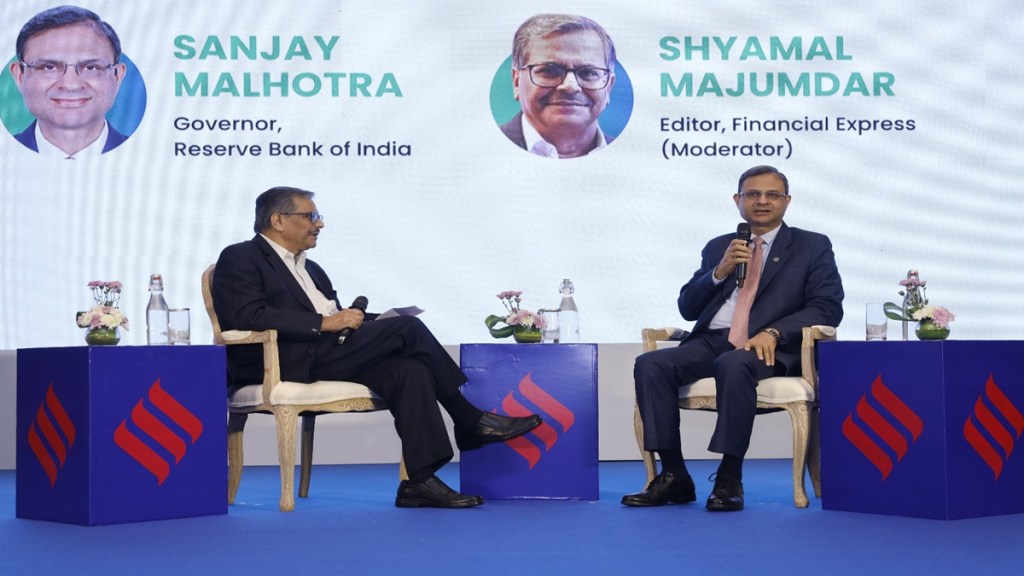Ahead of the monetary policy committee (MPC) meeting scheduled for August 6, Reserve Bank of India (RBI) Governor Sanjay Malhotra on Friday said the “bar for further easing (of rates) is now higher”, even though a neutral monetary policy stance means “we have the flexibility of moving up or down, or pause”.
While the MPC has lowered the benchmark repurchase rate by 100 basis points since February, “it does not mean a reversal of the easing policy, there still can be a cut”, he added.
Speaking to Financial Express Editor Shyamal Majumdar at the FE Modern BFSI Summit in Mumbai, Malhotra further said that “the battle against inflation is won, but the war continues”.
The central bank forecasts inflation for the current fiscal at 3.7%, though analysts expect the projections to be way below that.
Policy transmission, liquidity & simplification
The governor said the transmission of the 50 bp rate cut by the MPC in February and April has already happened within two months (by June). “Whatever we did stands validated, in terms of much faster transmission. Coming to the fact that whether we have anything left after having done all this, it would depend on what the requirement is. We believe that we have enough ammunition in our armoury,” he added.
According to Malhotra, the central bank’s primary objective is to maintain price stability, which is “not inconsistent” with the objective of growth. He also strongly defended the ‘surprise’ 100 bps cash reserve ratio (CRR) cut by saying that it should not be looked at from the perspective of liquidity management only, but it also reduces costs of intermediation so that benefits are passed on to the savers and borrowers.
The RBI will look at banking regulations with an aim to simplify rules for regulated entities, the governor said. The central bank will form a regulatory review cell that will assess regulations periodically to do away with obsolete rules and fix gaps to boost financial stability. Currently, work is going on to consolidate 8,000 regulations, as 5,000 have become obsolete. “Our attempt will be to have one master direction – one circular for entities. In the first phase, we are converting them into 33 subjects. But the endeavour is to have one circular for banks, one for NBFCs, and so on,” Malhotra said. In addition, there will be rationalisation of around 100-odd policies to enable sharper focus on making strategic decisions and policymaking.
In other attempts at ensuring efficiency, the RBI has already reduced the number of returns that the regulated entities have to submit so that there is improvement in compliance. Further, a regulation-making framework has been put in place that will focus on consultation and impact analysis. The whole exercise is to ensure a right balance between efficiency and financial stability.
UPI, ownership rules, and global currency talk
Among other things, Malhotra said that the Unified Payments Interface (UPI) is a public infrastructure and the government is subsidising the stakeholders such as banks, and the regulator will focus on providing security and efficiency. “In two years, the number of transactions through UPI has doubled from 300 million to 600 million…and it is sustainable till the cost is paid. Whether the government or someone else bears it, it does not matter,” he said.
He also reiterated that there is no proposal to review the corporate ownership of banks. Ruling out any review of promoter stake in private banks beyond the current 26%, the governor said: “We would like no individual person to exercise undue control over banks which are dealing with depositors’ money. Diversification of ownership is necessary.”
The RBI will also release a discussion paper on the flexible inflation targeting framework. “Flexibility in the inflation targeting framework allows us to address high food inflation volatility,” he said.
Malhotra also said there was not much work happening on a BRICS currency. “All countries are trying to diversify away from the dollar, but the dollar will be here for a long time.”
On the IndusInd Bank troubles, Malhotra said while a bank board has to be vigilant about all the goings-on, it cannot be held responsible for every misdemeanour at a lender.

